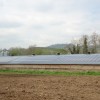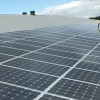Getting Paid for Generating Electricity
In 2009 the UK Government signed up to the EU Renewable Energy Directive effectively agreeing to generate 15% of our nation’s energy needs from renewable sources by 2020. To help meet this target our Government is providing significant financial incentives to property owners and businesses via a renewable energy Feed-In-Tariff (FIT) scheme.
The FIT scheme for Solar PV systems includes a payment for each kWh of electricity generated irrespective of who consumes it. There is an additional payment for each kWh actually or, in some instances, deemed to have been exported for third party consumption. Consuming some of self-generated electricity also reduces your electricity bill.
Revised Feed-in-Tariff Payments
The UK Government announced new Feed-In-Tariff payments in late October 2011, effective from April 1st 2012. Owners of new PV Systems installed from December 12, 2011, will receive the 2011/12 FIT payments up to March 31st 2012 with the revised 2012/13 payments applying thereafter.
| System Size (kW) |
Generation Tariff |
Generation Tariff |
|---|---|---|
| |
2011/12 - per kWh |
2012/13 - per kWh |
| 4 kW (retrofit) |
43.3 pence |
21.0 pence |
| 4 kW (new building) |
37.8 pence |
21.0 pence |
| Over 4 to 10 kW |
37.8 pence |
16.8 pence |
| Over 10 to 50 kW |
32.9 pence |
15.2 pence |
What does this mean in practice?
All new technology markets evolve in the same way with the early adopters gaining the best returns because they took higher risks and paid more as pioneers. As more people install solar energy, so solar hardware prices soften which means the cost of entering the market falls and the prospective customer base increases. Yes, things have happened very quickly, but Salop Energy Commercial plans well ahead taking account of dramatic scenarios such as ’What if the Tariff was cut by 50%?’.
Example Offering Around a 10% Annual Income Stream
An average residential customer installing a 4kW roof mounted Salop Energy Commercial Premium Brand Solar PV System on their home can expect to receive an annual FIT income of around £750 and trim £200 off their commercial electricity bill reaping rewards worth £950. Payments are tax free for most UK taxpayers and will be revised upwards annually on April 1 for any gain in the Retail Price Index.
The cost of the 4kW system fully installed, including an allowance for scaffolding fees and Vat at 5%, will be around £8,400. This price excludes any roof strengthening or repair work commissioned.
This is despite the Generation Payment element of the Tariff more than halving to 21 pence per kWh generated from December 8.
Of course the timing and limited notice of the changes have come as a shock to the industry, but have come as no great surprise to Salop Energy Commercial. “It’s been clear to us for some time that the current regime is not economically sustainable, so the Feed-in-Tariff re-balancing exercise comes as no great surprise.�? said Director Gareth Jehu. “We’ve been out to Germany twice in October 2011 to fine tune our business plans in anticipation of a major change. The fact is that we as a company will continue to provide our solar PV customers with a 10% or better investment return plus a ‘carbon reduction’ dividend too.�?
FIT Solar PV Payment Structure
Qualifying PV Investors are rewarded in three ways:
Generation Tariff – a set rate paid by the FIT Licensee (usually an energy supplier) for each unit (or kWh) of electricity generated. This rate may change for new entrants from time-to-time, but once you join your entry tariff will be set. FIT payments are thereafter reviewed annually (April 1) increasing in line with any gain in the Retail Price Index. Historically RPI has averaged 2.5% p.a. and for the FIT scheme for Solar PV runs for 25 consecutive years.
| System Size (kW) |
Export Tariff |
Generation Tariff |
|---|---|---|
| |
2011/12 - per kWh |
2012/13 - per kWh |
| 4 kW (retrofit) |
3.1 pence |
21.0 pence |
| 4 kW (new building) |
3.1 pence |
21.0 pence |
| Over 4 to 10 kW |
3.1 pence |
16.8 pence |
| Over 10 to 50 kW |
3.1 pence |
15.2 pence |
* We’re still waiting to learn what the Export Tariff will be from April 1 2012
Export Tariff – for each kWh of electricity exported back to the Grid 3.1 pence is payable (reviewed for RPI gain April 1, 2012). However, there are two options to consider relating to how the exported energy is measured. For Solar PV Systems below 30kW it is possible to avoid the cost of installing an Export Meter (c. £200) by simply electing to have your export deemed (fixed) at 50%. For most householders and small businesses the ‘50% deemed’ option makes most sense. It avoids paying for an Export Meter requiring the export of around 6,450 kWh just to pay back its c. £200 cost. This might take owners of small systems several years to achieve
Another factor to consider is the Government’s intention that the UK switches to using Smart Metering in the near term. These energy meters have a built in Export Meter, so why invest in a freestanding Export Meter when it is destined to be redundant? Once installed, a Smart Meter will most likely kill the ‘50% Deemed Export’ option as your FIT Licensee will be able to read your electricity meter for both imports and exports from their offices.
Electricity Bill Savings - When PV investors consume some of the electricity they’ve generated within their homes or business premises, they’ve avoided buying it from their commercial electricity provider. Consequently their commercial electricity bills will be lower than would otherwise have been the case.
It is the sum of these three parts that give Solar PV Investors a return on their investment.
Example: A UK taxpayer generating 3000kWh in the 2012/13 FIT year from a roof mounted system on their main residence might receive:
3000 X 21.0 pence generation tariff = £ 630.00
1500 X 3.1 pence export tariff = £ 46.50
TOTAL= £ 676.50
If 1500 kWh of home generated electricity were consumed on site then on a standard domestic bill around 1500X 13pence +5%Vat would be saved on an average commercial electricity bill = £204.75.
This means the value of income and savings would be £881.25 (£676.50 + £204.75)
For UK taxpayers generating PV electricity from their homes the income element is tax free provided some of that electricity is consumed on site.
Purely from an investment view some key questions are:
- How much interest would the installation capital have earned in a savings account?
- Would the return have beaten inflation preserving the value of your capital?
- Would the income have been tax free?
- Is the return available for 25 years?
Solar PV FIT schemes run for 25 years and payments are adjusted annually for any gains in the Retail Price Index. However, the FIT proposition for new solar PV investors should offer the prospect of superior returns for quite some time to come, relative to just holding cash on deposit.
Environmental Benefits
Very few investments benefit the environment and Solar PV is one of the exceptions. The generation process does not produce any pollution, is silent in operation and displaces fossil fuel consumption.
In May 2011 the Government announced a quite separate target, aiming to cut Britain’s emissions by 50 per cent from 1990 levels by 2027. Removing FIT payments altogether seems an unlikely proposition given the bold renewable energy targets accepted for the UK.
Tip: To work out your FIT income under the ‘50% Deemed Export’ option, divide the Export Tariff by 2 (3.1 pence/2 = 1.55 pence) and add this to your Generation Tariff, e.g. 21.0 pence + 1.55 pence = 22.55 pence. Multiply 22.55 pence by the number of kWh reported by your generation meter to quantify your FIT income.
Tip: To maximise consumption of home grown energy try and use electricity hungry appliances such as washing machines, vacuum cleaners and dishwashers etc. on sunny days around midday. Try not to use two high energy devices at the same time, or at night.
Choosing a FIT Licensee
FIT Licensees are predominantly energy suppliers segmented into Mandatory FIT Licensees - currently the 7 big energy suppliers and Voluntary FIT Licensees presently 13 smaller businesses. A full list of FIT Licensees can be found on the OfGem website.
Many people opt to appoint their existing energy supplier, but there is no obligation to do so. FIT Application forms are generally available to download from FIT Licensee websites – they vary in length and demands. Some Licensees will only accept the ‘Deemed Export’ applications for smaller PV systems.
If you have difficulty filling in forms Salop Energy Commercial will help you complete your FIT application.
FIT Payments are usually paid with a quarterly frequency in arrears. Your FIT Licensee will provide you with generation meter reading instructions to trigger payment. You may find it helpful to mark on a calendar or diary when generation meter readings fall due.
Summary
The Feed-in-Tariff may have decreased, but so has the cost of installing a solar PV system. This has made solar energy more accessible and still maintains a better investment return than is currently on offer from the banks. The income is RPI linked so hedging inflation and is generally tax free for domestic installations owned by UK taxpayers. The investment term is 25 years and the FIT contract benefits can be transferred to a new property owner. It will take around 10 years to recover your investment sum, but many of our clients use their FIT income to help meet their energy bills.
















